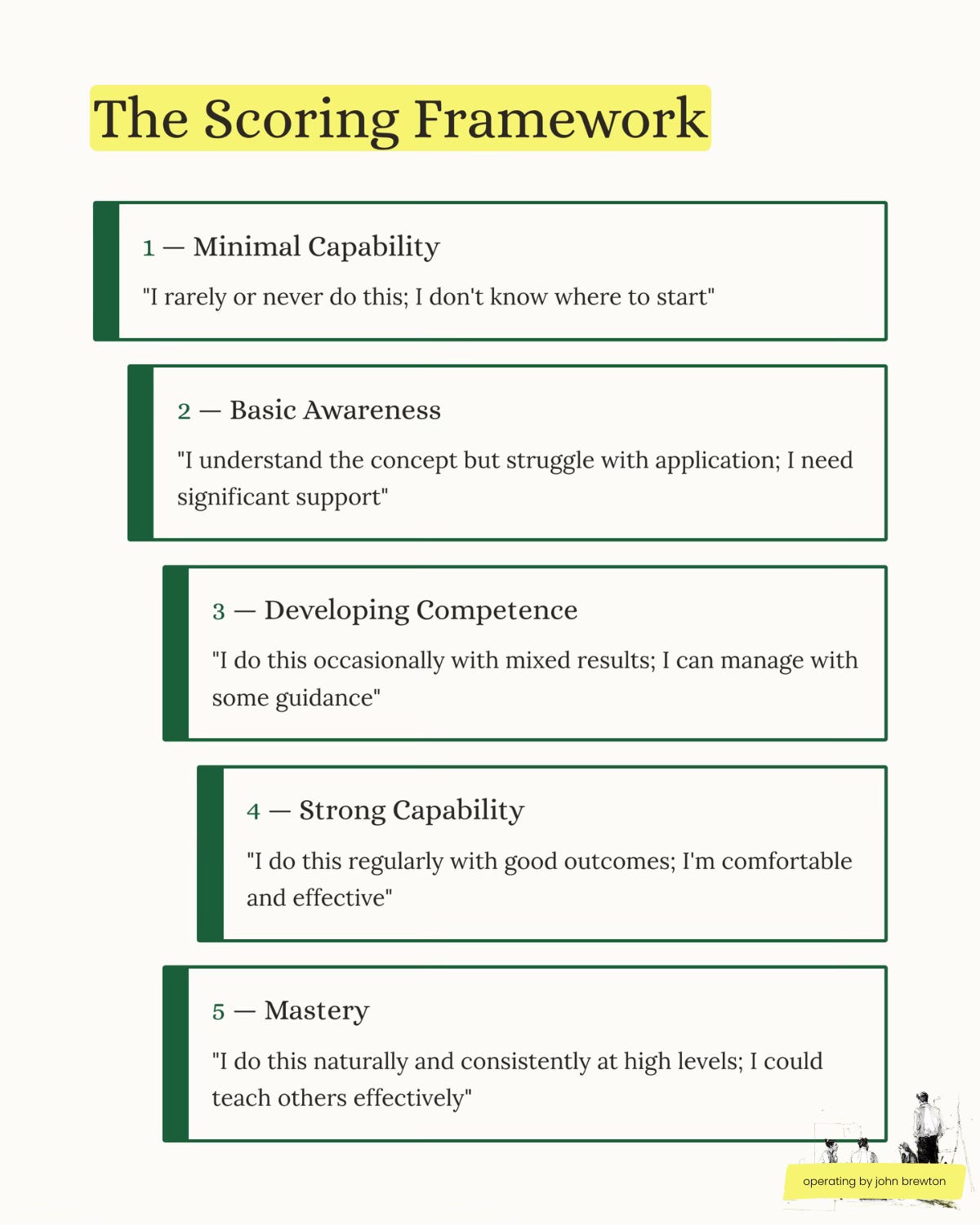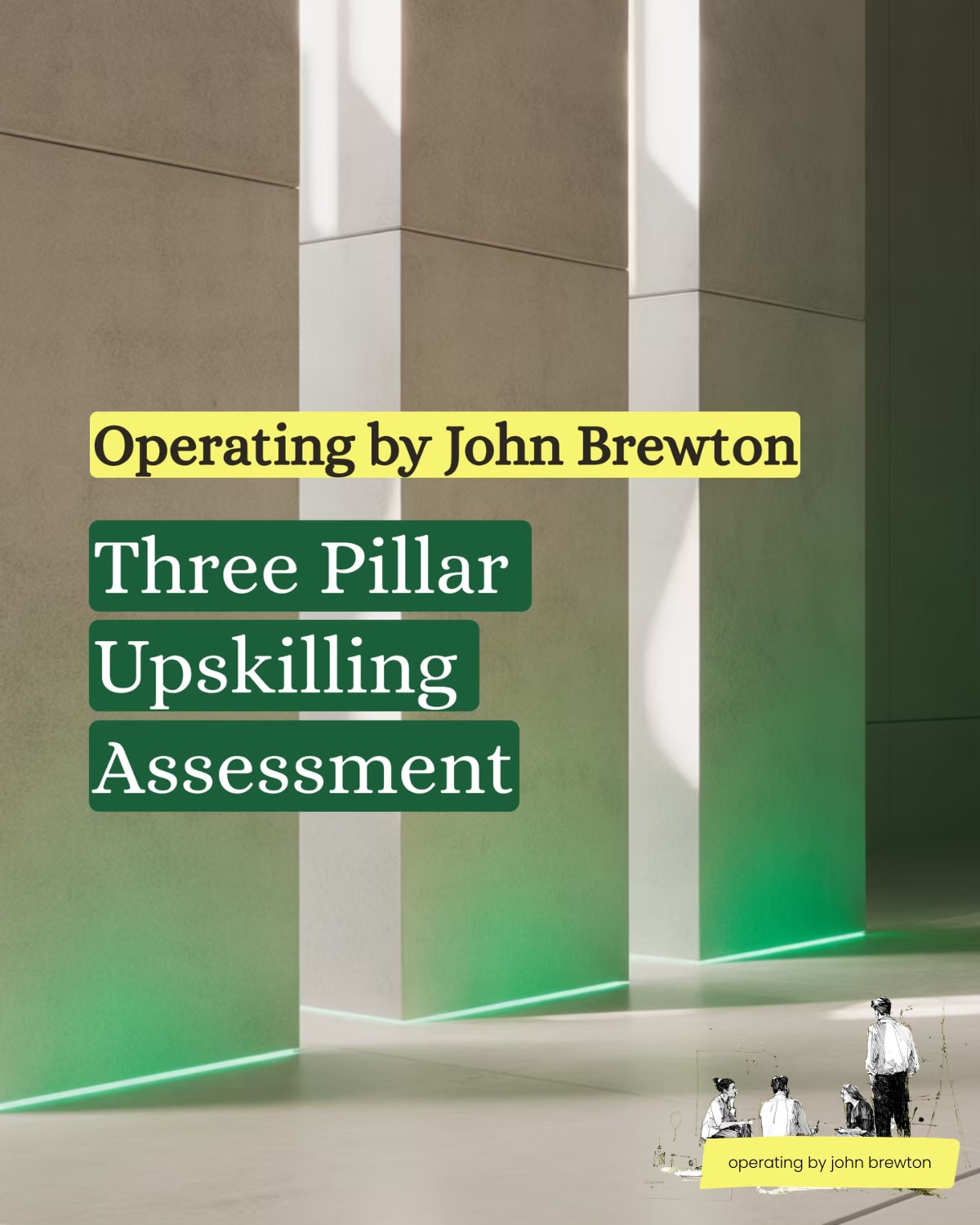The Ultimate Upskilling Playbook: Your Step-by-Step Guide to Building AI-Era Career Resilience
A comprehensive, actionable workbook with frameworks, assessments, practical exercises, and templates for mastering the Three Pillars of AI-era success
Between now and December 31st, you’re going to build something most professionals won’t have heading into 2026: a systematic roadmap for thriving in the AI era.
This isn’t about adding another AI tool to your workflow or completing another online course that collects digital dust. This is about developing the integrated capability set that research from Harvard, MIT, Wharton, Stanford, and Berkeley confirms separates those who leverage AI effectively from those who struggle with it.
The awareness-action gap is stark. Executives recognize AI as transformational (97% in recent McKinsey surveys) but only 13% of organizations report creating measurable business value from AI deployment.
The difference isn’t access to technology. It’s systematic development across three interconnected skill domains that most professionals are navigating without a map.
Over the next six weeks, we’re building that map together.
What We’re Building: A Research-Backed Framework for the AI Era
Organizations that invest in comprehensive workforce development alongside AI deployment achieve profitability gains exceeding 40% while freeing up over 50% of labor capacity for higher-value work. Research across top business schools and consulting firms reveals a consistent pattern: success in the AI era requires the concurrent development of technical capabilities, distinctly human strengths, and strategic business acumen.
This playbook structures that development into a manageable, actionable six-week journey. Each week builds on the last. Every installment includes frameworks you can implement immediately, assessments that reveal your development priorities, and exercises designed for real-world application.
The Three Pillars Framework
The foundation of this playbook rests on the Three Pillars. These are three skill domains consistently identified as determining AI-era success:
Pillar One: AI Fluency and Technical Competencies
This is your baseline literacy. Understanding what AI actually is and isn’t. Using AI tools effectively in your daily work. Deploying workflow automation. Interpreting data-driven insights with appropriate skepticism. Building capability in prompt engineering and understanding emerging agentic systems. This pillar represents the technical foundation everyone needs, regardless of role or industry.
Research from MIT and Deloitte confirms that technical competency frameworks must balance role-specific skills with behavioral capabilities, knowing how to use the tools matters, but so does knowing when to use them and when human judgment should prevail.
Pillar Two: Human-Centric Capabilities (EPOCH)
MIT identifies five distinctly human strengths that AI cannot replicate and that become increasingly valuable as AI handles routine analytical work: Empathy and emotional intelligence, Presence and networking, Opinion and judgment, Creativity and innovation, and Hope and vision.
These capabilities are harder to develop than technical skills. Harvard’s competency research emphasizes that human-centric skills require experience, reflection, and feedback loops rather than just coursework. They develop through dozens of interactions, build cumulatively over months, and have no clear completion points. But they’re also what enables leadership, influence, and the kind of strategic decision-making that creates organizational value.
Wharton’s Leadership 360 assessment framework, which measures seven leadership competencies through behavioral observation, confirms that these human capabilities directly correlate with team performance, decision-making quality, and collaborative outcomes.
Pillar Three: Strategic and Business Acumen
Strategic thinking. Systems thinking. Financial literacy. Domain expertise. Entrepreneurial capability. Change management. These competencies separate those who execute tasks from those who understand how their work contributes to organizational success.
BCG’s capability-building research emphasizes that strategic competencies must be anchored to observable behaviors and business outcomes, not vague aspirations. Knowing strategy frameworks matters less than being able to apply them to identify competitive advantages, anticipate market shifts, and connect daily work to organizational value creation.
Why All Three Pillars Matter
The emphasis shifts by career stage, individual contributors typically need 40% focus on AI fluency, 35% on human capabilities, and 25% on strategic acumen. At the same time, executives reverse that emphasis to 10% technical, 25% human, and 65% strategic, but all three pillars remain essential at every level.
Technical skills without strategic acumen leads to execution without impact. Strategic thinking without AI fluency leaves opportunities unrealized. Human capabilities enable the influence and leadership required to implement anything at all.
Your Six-Week Journey
Each Wednesday through the end of the year, you’ll receive a new installment with frameworks, exercises, and downloadable resources, all free, nothing behind a paywall. Think of this as my end-of-year holiday gift to everyone!
Here’s what we’re building together:
Week 1 (Today, November 20): Foundation and Self-Assessment
Where are you now across the three pillars? What are your current capabilities and gaps? What should you prioritize over the next 90 days? We’ll utilize a research-backed self-assessment framework based on behaviorally anchored rating scales, and developed in relatioships to how teams at Harvard Business School, Wharton, and leading consulting firms to objectively evaluate capabilities.
Deliverable Number One: Complete Three Pillars Assessment with your personalized development priorities identified
Week 2 (November 27): The Three Pillars Framework Deep-Dive
We’ll unpack the complete research foundation behind the framework. Why these three domains? How do they interconnect? What does the evidence from Harvard, MIT, Wharton, Stanford, and Berkeley actually show about AI-era skill requirements? How should you customize your approach based on your role (individual contributor, manager, executive) and industry?
Deliverable Number Two: Visual framework guide and career stage customization worksheet
Week 3 (December 4): AI Fluency Quick Wins
Foundational AI literacy—what you actually need to know versus what’s hype. The ten essential prompt patterns every professional needs. Identifying your first automation opportunity and implementing it. Moving from AI awareness to AI application.
Deliverable Number Three: Prompt pattern library and automation implementation template
Week 4 (December 11): EPOCH Development Strategies
Building the human capabilities AI cannot replicate. Practical exercises for developing emotional intelligence, judgment, creativity, and presence. Why these skills are harder to develop than technical competencies and what that means for your approach. Moving beyond awareness to deliberate practice.
Deliverable Number Four: 30-day EPOCH development practice guide
Week 5 (December 18): Strategic Thinking Frameworks
Essential frameworks for business model analysis, systems thinking, and financial literacy. Connecting your work to organizational value. Moving from tactical execution to strategic contribution. Understanding how AI changes competitive dynamics and what that means for your strategic thinking.
Deliverable Number Five: Strategic frameworks toolkit with application exercises
Week 6 (December 25/January 1): Integration and Your 2026 Roadmap
Synthesizing all three pillars into your personalized 90-day transformation plan. Taking stock of your progress over the past five weeks. Setting concrete development goals for Q1 2026. Preview of the advanced deep-dive content launching in January for paid subscribers.
Deliverable Number Six: Complete 90-day transformation roadmap customized to your role and priorities
Your Starting Point
The Three Pillars Self-Assessment
Before developing new capabilities, you need to know where you are now. This assessment takes 10-15 minutes. It uses behaviorally anchored rating scales, a methodology developed by organizational psychologists and validated across Harvard, Wharton, MIT, and leading consulting firms.
Unlike traditional rating scales that rely on vague descriptors like “good” or “needs improvement,” behaviorally anchored scales tie each rating to observable, specific behaviors. This reduces subjectivity and provides clearer guidance for development. Each rating describes what performance at that level actually looks like in practice.
How to Approach The Assessment
The Assessment
Click here to Download and Begin Your Assessment
Common Professional Profiles
How to Get Maximum Value
Commit to the Full Six Weeks
Transformation requires sustained effort. Research on habit formation confirms that consistency matters more than intensity, daily 30-minute sessions outperform monthly eight-hour marathons.
Block 30-45 minutes every Wednesday for the next six weeks. Protect this time as you would any critical meeting. Read the installment, complete the exercises, and implement at least one framework in your actual work before the next week arrives.
Apply Immediately to Real Work
Every framework in this playbook is designed for immediate application. Don’t just read, implement, and test concepts against your actual work. Document what works and what doesn’t. Learning occurs through application, not consumption.
Build Your Learning Community
Find an accountability partner, someone also committed to AI-era skill development who will check in weekly on progress. Forward this article to them now. Commit to 15-minute weekly check-ins where you share what you implemented and what you learned.
Join the conversation in the comments. Share your assessment results (no need to share specific scores, just your priority pillar and what surprised you). Knowing others are on the same journey creates accountability and reveals insights you might miss alone.
Wharton’s research on leadership assessment emphasizes that self-reflection combined with external perspectives produces the most accurate self-awareness.
Track Your Progress Visually
Document your baseline scores today. Retake the full assessment at Week 3 (mid-point check) and Week 6 (end of series). Visible progress builds momentum and helps you see where focused effort is paying off.
Use the tracker I’ve created for you here to monitor your progress. The act of tracking creates awareness, and awareness drives behavior change.
What You’ll Gain by December 31
Your First Actions
1. Complete the Self-Assessment Above (15 minutes)
Calculate your three pillar averages right now. Don’t overthink the scores—your first instinct is usually most accurate. Identify your lowest pillar and your three lowest-scoring individual dimensions. Write them down.
2. Share Your Focus in the Comments
Public commitment significantly increases follow-through. Research on goal-setting and behavior change consistently shows that sharing intentions with others creates accountability that private commitments lack.
3. Subscribe to This Section
Click the subscribe button to receive each Wednesday’s installment. You can subscribe specifically to the “AI Upskilling Playbook” section without getting all Operating content, this ensures you get every weekly release without inbox overload.
4. Forward to Your Accountability Partner
What’s Coming Next Week
Week 2: The Three Pillars Framework Deep-Dive—The Research Foundation
We’ll unpack the complete evidence base behind this framework:
What does research from Harvard Business School, MIT Sloan, Wharton, Stanford Digital Economy Lab, and Berkeley actually show about AI-era skill requirements? Why these three pillars specifically?
How do they interconnect and reinforce each other?
What does capability development look like at different career stages?
How should you customize your approach based on your role (individual contributor, manager, executive), industry, and assessment results?
You’ll leave Week 2 with a visual framework guide, role-specific customization worksheets, and a clear understanding of why developing across all three pillars matters more than deep specialization in just one.
A Note on This Format
I’m treating this playbook as a living resource built in public. Your feedback shapes how we progress. If sections resonate, I’ll go deeper. If exercises need refinement based on your real-world application, we’ll iterate together.
This is collaborative development, I’m providing the research-backed frameworks and structure, you’re providing the real-world validation and insights from implementation. The comment section isn’t just for engagement—it’s where we refine these concepts together based on what actually works in your context.
The stakes are high. The research is clear. The difference between those who thrive in the AI era and those who struggle is systematic, continuous development across AI fluency, human-centric capabilities, and strategic business acumen.
Over the next six weeks, we’re building that capability together.
What’s your biggest skill gap right now? Share your assessment results and priority development area in the comments below.
This is Week 1 of The Ultimate Upskilling Playbook, a six-week journey to building AI-era career resilience. Subscribe to receive all installments, downloadable frameworks, and access to the community of professionals on the same development path. In January 2026, advanced deep-dive content launches for paid subscribers.
Operating by John Brewton goes deep on what it takes to build, scale, and optimize modern companies. This breakdown analysis is just the starting point. Check out last week’s analysis of Amazon’s current operating strategy to see more.
John Brewton documents the history and future of operating companies at Operating by John Brewton. He is a graduate of Harvard University and began his career as a Phd. student in economics at the University of Chicago. After selling his family’s B2B industrial distribution company in 2021, he has been helping business owners, founders and investors optimize their operations ever since. He is the founder of 6A East Partners, a research and advisory firm asking the question: What is the future of companies? He still cringes at his early LinkedIn posts and loves making content each and everyday, despite the protestations of his beloved wife, Fabiola, at times.












I love this focus.
The awareness that you need to be systematically developing the three pillars...technical, human-centric, and strategic...is the defining differentiator for the next decade of career success.
Really appreciate how clearly this playbook lays out a practical, research-backed path for building AI-era skills. It makes the journey feel achievable!